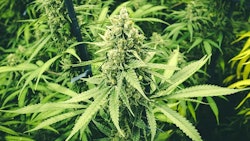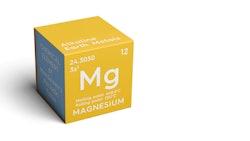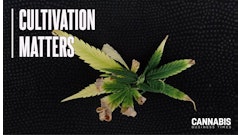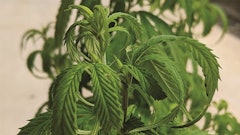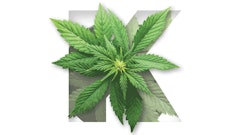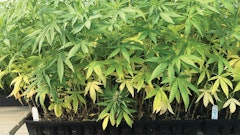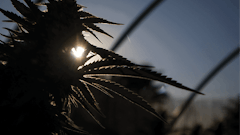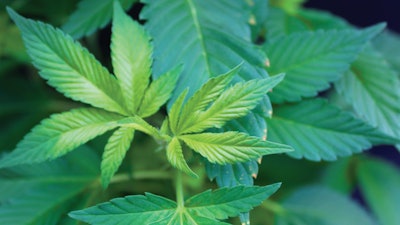
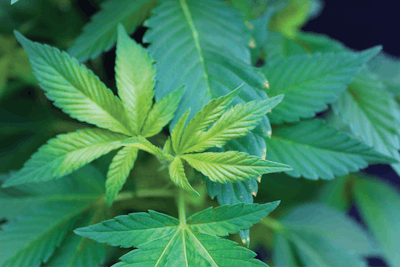
While magnesium (Mg) is sometimes a forgotten element, sulfur (S) is actually ignored. Few fertilizer bags even list the amount of S provided. Typically, it is only listed as an ingredient, and the main amount of S supplied is from the associated sulfate (-SO4) attached to the micronutrients. This low amount provided as part of the micronutrients is generally insufficient to meet plant demands.
One reason S has not received much attention is because atmospheric S has been readily available due to the burning of high sulfur coal. In the 1966 book, “Sand and Water Culture Methods Used in the Study of Plant Nutrition,” author E.J. Hewitt states that in the United Kingdom, S deficiencies are rarely seen within close proximity to cities or towns due to the use of household coal-burning heating units. With the increased use of low-S containing coal and natural gas for electricity generation, the amount of atmospheric S available to plants is diminishing. To compensate for this shift, agricultural applications of S-containing fertilizers such as potassium sulfate (K2SO4), calcium sulfate (CaSO4), and magnesium sulfate heptahydrate (MgSO4.7H2O) have increased.
With greenhouse cannabis production, we require fertilizers to be readily water soluble. Sulfate-based fertilizers such as K2SO4, CaSO4 and MgSO4.7H2O easily precipitate out of solution into insoluble forms. The primary culprit is CaSO4, which is gypsum and commonly used as wallboard in building construction. So the S fertilization strategy must be customized to meet the demands of the greenhouse environment.

Evaluate Your Fertilizer Program
The first step in determining if you are providing enough S is to evaluate your fertilization program. Sufficient levels of S usually are not provided by the irrigation water. (In most cases this is ideal, for S in the hydrogen sulfide form (H2S) is associated with the rotten egg smell.) Ideally, fertilizer and the corresponding substrate S levels should be in the 50 to 200 ppm range. Assuming the availability of a baseline level of atmospheric S, the critical lower target range should be above 25 ppm S. Higher levels of S generally are considered to be non-toxic, but there is a limit above ~300 ppm. Elevated S levels can inhibit the plant’s ability to uptake both boron (B) and molybdenum (Mo). The key for plant nutrition is balancing all the factors that impact uptake to optimize growth.
Because S concentrations are typically not listed on most fertilizer bags, you will need to send a fertilizer solution sample to a commercial lab to obtain a complete analysis of the S and the other elements contained in your fertilizer. This is an invaluable test that should be done to ensure that your overall fertilization program is on track.
Sulfur Deficiency Symptoms
Cannabis (Cannabis sativa) plants can develop symptoms of S deficiency, but the occurrence is much lower than, say, a nitrogen (N) deficiency. Sulfur and N deficiencies have very similar leaf symptomology. The key is observing where on the plant the symptoms first appear. Nitrogen is a mobile element, which means when the plant senses that N is low, it will remobilize N from the older leaves to the younger growth. That is why N deficiency symptomology of total leaf chlorosis (yellowing) initially appears on the older, lower leaves. (Note: With advanced N deficiencies, the symptomology will work its way up the stem into the middle section of the plant, which can confuse the diagnosis.)
Sulfur is a partially mobile element. In most S-deficiency situations, symptoms of leaf yellowing will appear in the middle section of the plant on the recently matured stage of leaves (Fig. 4). This is the case when N is also amply provided. If at the same time, N levels are inadequate, S deficiency symptomology can overlap in lower portions of the plant in the same region where N symptomology will appear. This makes diagnosing the situation more challenging and reinforces the need to submit a tissue sample to a commercial lab for complete nutrient analysis to confirm your diagnosis.
The typical progression of S symptomology begins as an overall pale discoloration of the middle zone leaves (Fig. 2A). This yellowing is associated with a drastic decrease in chlorophyll concentration in the leaf due to the plant’s inability to synthesize key amino acids. The pattern of how the chlorosis first appears on the leaf will aid in diagnosing S deficiency. Typically chlorosis first appears at the leaf base and progresses outwards toward the leaf tip (Fig. 1). As symptoms progress, the overall level of yellowing intensifies (Fig. 2B&C). With advanced conditions, due to the lack of chlorophyll, sun burning of the leaves will result in the appearance of necrotic spots. Plant growth will also be stunted (Fig. 3). In general, the S sufficiency range for cannabis is between 0.17 percent to 0.26 percent as suggested by Bryson and Mills in “Plant Analysis Handbook IV.”
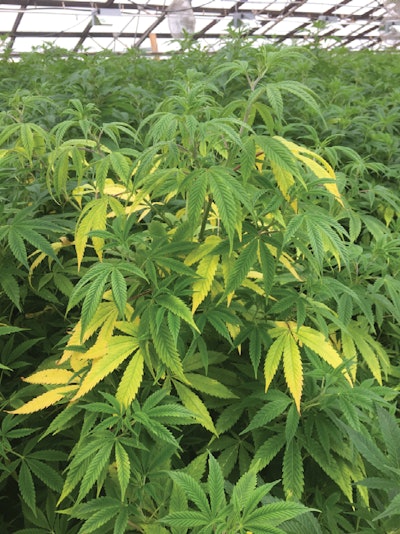
Corrective Procedures
The fix for S deficiency is easy. Epsom salts (magnesium sulfate) can be applied at the rate of 2 pounds per 100 gallons of water (2.4 kg/1000L). Apply this as a 5 percent to 10 percent flow-through leaching irrigation. This will stop symptom progression but will not reverse any severe leaf chlorosis or necrotic spotting. For regions that lack sufficient S in irrigation water and S is not part of the regular fertilization program (i.e., 20-10-20 does not contain significant amounts of S), monthly applications of Epsom salts at the rate of 1 pound per 100 gallons of water (1.2 kg/1000L) is the common production practice to green up plants and avoid deficiencies. (Also note, avoid mixing Epsom salts with calcium (Ca)-based fertilizers, as this will result in an insoluble precipitate forming in the fertilizer container.)
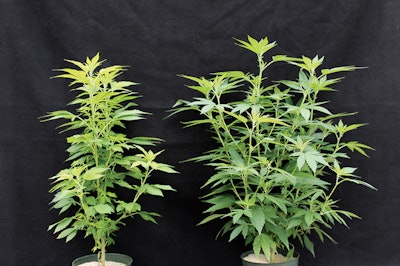
Conclusions
Symptoms of S deficiency readily develop on cannabis. Growers need to increase the amount of S available from the irrigation water, and provide supplemental S to the plants as needed to avoid further deficiencies.









